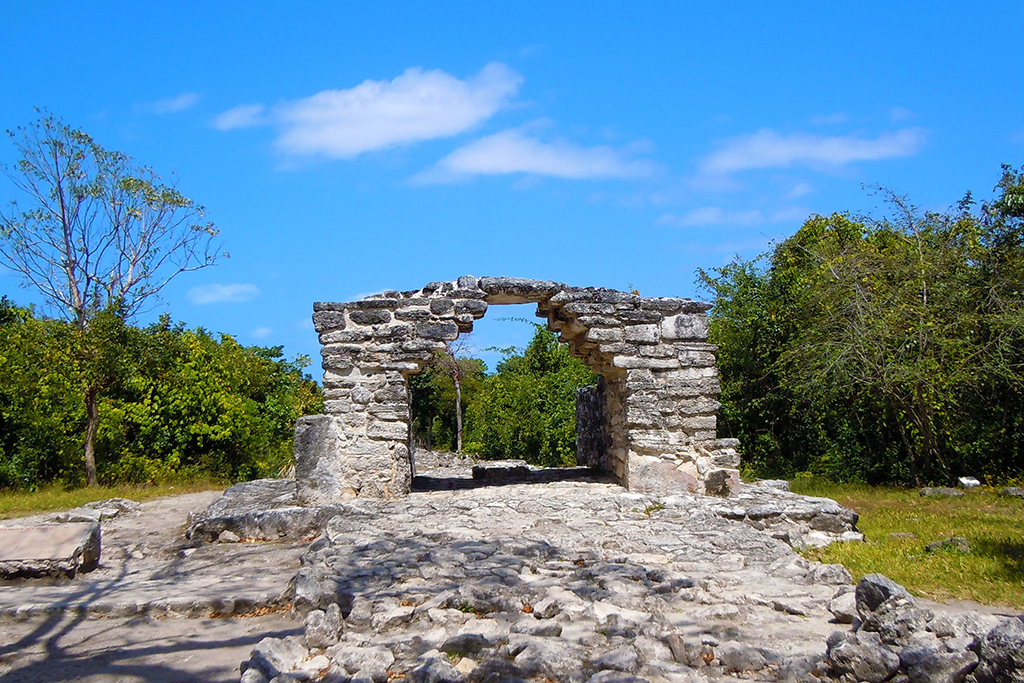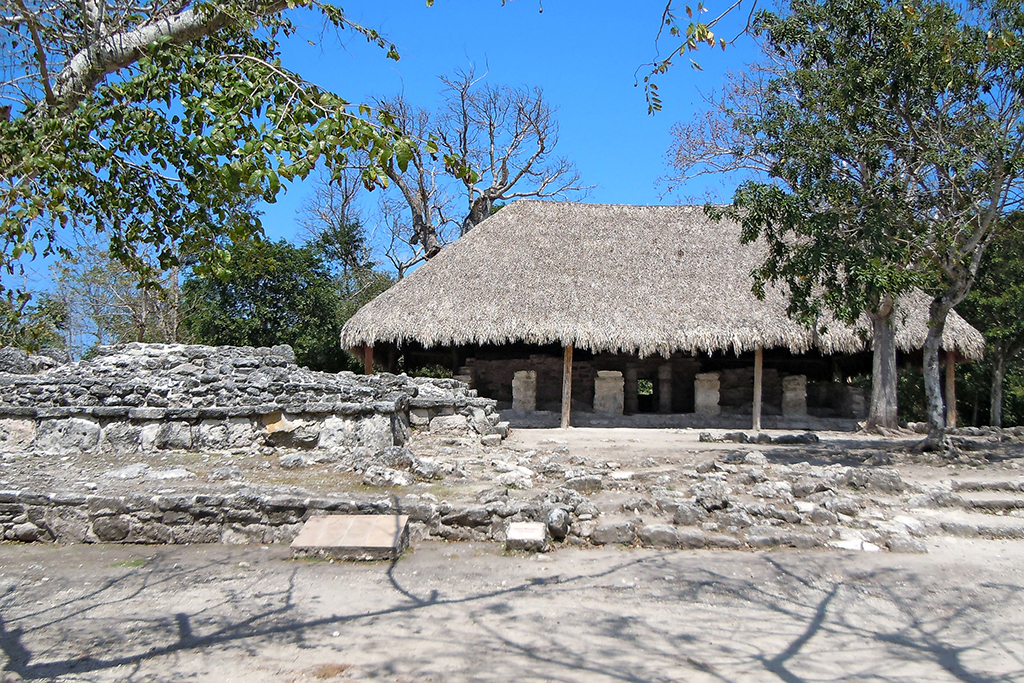Isla Cozumel played a deeply significant role in the Maya world as an important port of trade and, more importantly, as one of three major destinations of religious pilgrimages (the others were Izamal and Chichén Itzá, both in Yucatán state). The island’s primary site—known as San Gervasio today—was dedicated to Ixchel, the Maya goddess of fertility as well as of the moon, childbirth, medicine, and weaving. Archaeologists believe that every Maya woman was expected, at least once in her lifetime, to journey to Cozumel to make offerings to Ixchel for fertility—her own, and that of her family’s fields. Cozumel’s draw was powerful, as inscriptions there refer to places and events hundreds of miles away.
Over 30 archaeological sites have been discovered on the island, though only four are easily accessible, and only the largest—San Gervasio—can properly be called a tourist attraction. San Gervasio is certainly not as glorious as ruins found on the mainland, but it’s worth a visit all the same.

San Gervasio. Photo © Juris Didrihsons/123rf.
The area around San Gervasio (Cross-Island Hwy. Km. 7.5, 8am-4pm daily, US$9.50) was populated as early as AD 200 and remained so after the general Maya collapse (AD 800-900) and well into the Spanish conquest. In fact, archaeologists excavating the ruins found a crypt containing 50 skeletons along with numerous Spanish beads; the bodies are thought to be those of 16th-century Maya who died from diseases brought by the conquistadors.
Guides can be hired at the visitors center for a fixed rate: US$20 for a one-hour tour in Spanish, English, French, or German.Today’s visitors will find a modest ruin, whose small square buildings with short doors are typical of those found elsewhere on the island. This style, known as oratorio, almost certainly developed in response to climatic imperatives: Anything built here needed to withstand the hurricanes that have pummeled Cozumel for millennia.San Gervasio has three building groups that are accessible to the public—Las Manitas, Plaza Central, and Murciélagos; all are connected by trails that follow the same ancient causeways used by the city’s original inhabitants. A fourth building group—El Ramonal—is not yet open to the public.
Entering the site, you’ll come first to the building group named after the structure Las Manitas (Little Hands), for the red handprints still visible on one of its walls. This structure is thought to have been the home of one of San Gervasio’s kings, Ah Huneb Itza, and the inner temple was likely a personal sanctuary. Just east of the Las Manitas building is Chi Chan Nah; consisting of two rooms, it is the smallest structure in San Gervasio. The exact purpose of this building is unknown, though it is theorized that it was used for rituals.

San Gervasio. Photo © Juris Didrihsons/123rf.
Bearing left, the trail leads to the Plaza Central, a large courtyard surrounded by nine low structures in various states of decay; it is believed that the structures were made taller with wood extensions. The Plaza Central served as the seat of power in San Gervasio’s latest era, from AD 1200 onward. At the northwest side of the Plaza Central is the somewhat precarious-looking El Arco (The Arch), which served as an entrance to this section of the city.
At 0.5 kilometer (0.3 mile) from the Plaza Central is the Murciélagos (Bats) building group, containing the site’s largest and most important structure: Ka’na Nah (Tall House). Also dating to San Gervasio’s later era, this was the temple of the goddess Ixchel, and in its heyday would have been covered in stucco and painted red, blue, green, and black.
Finally, on the northeastern edge of San Gervasio rests Nohoch Nah (Big House), a boxy but serene temple. With an interior altar, the temple might have been used by religious pilgrims to make an offering upon entering or leaving San Gervasio. It was originally covered in stucco and painted a multitude of colors.
Guides can be hired at the visitors center for a fixed rate: US$20 for a one-hour tour in Spanish, English, French, or German. Prices are per group, which can include up to four people. Tips are customary and are not included in the price.
El Cedral is the “other town” on Cozumel, a sleepy village south of San Miguel that’s home to a small historic church and modest Maya structure of the same name. It’s got a pleasant central plaza, and tour operators, including horseback riding guides, often bring visitors here to visit the church and temple, and to peruse the souvenir stands normally set up here. Once a year, El Cedral hosts one of Cozumel’s largest festivals, a 10-day blowout celebration of the Catholic holy cross.
El Cedral is famous for its Fiesta de la Santa Cruz (Festival of the Holy Cross), which begins in late April and culminates on May 3.Although overshadowed by San Miguel today, El Cedral is actually the older settlement. It was here that a group of 18 families of indigenous Christian converts fled in 1847 to escape persecution by fellow Maya during the War of the Castes. They came bearing a small wooden cross known as Santa Cruz de Sabán (Holy Cross of Sabán) and founded their church and village alongside a Maya temple that they discovered just inland from their landing site. The group was led by Casimiro Cárdenas, whose descendants still serve as caretakers, or mayordomos, of the temple and church; there’s a statue of Don Casimiro in the central plaza.El Cedral is famous for its Fiesta de la Santa Cruz (Festival of the Holy Cross), which begins in late April and culminates on May 3. The celebration includes food, music, dance, performances, rodeo, and fireworks aplenty, and even some traditions of distant Maya origin. The party is open to everyone, including tourists, and makes for a fun and fascinating outing if your visit happens to coincide with it.
A well-marked turnoff just south of Playa San Francisco leads 5 kilometers (3.1 miles) to the village. El Cedral’s Maya ruin (8am-5pm daily, free) is small and underwhelming, though it still bears a few traces of the original paint and stucco. The church is directly adjacent and contains the original wooden cross borne by El Cedral’s founders.
Located inside Parque Punta Sur (Carr. Costera Sur Km. 27, tel. 987/872-0914, 9am-5pm daily, US$14 adult, US$8 child under 12), El Caracol is a small, conch-shaped structure that dates to AD 1200. It’s believed to have been a lighthouse where Maya used smoke and flames to lead boats to safety. Small openings at the top of the structure also acted as whistles to alert Maya to approaching tropical storms and hurricanes. Admission to the reserve includes access to this small site.
Castillo Real is a partially excavated site with a temple, two chambers, and a lookout tower. It is believed to have been a Maya watchtower to protect against approaching enemies. It’s located on the remote northeastern corner of the island, along the sand road leading to Punta Molas. The road is quite treacherous, such that even ATVs and motorcycles can have trouble making it. Ask at the tourist office for the latest before making any plans to head up there.
Excerpted from the Twelfth Edition of Moon Cancún & Cozumel.